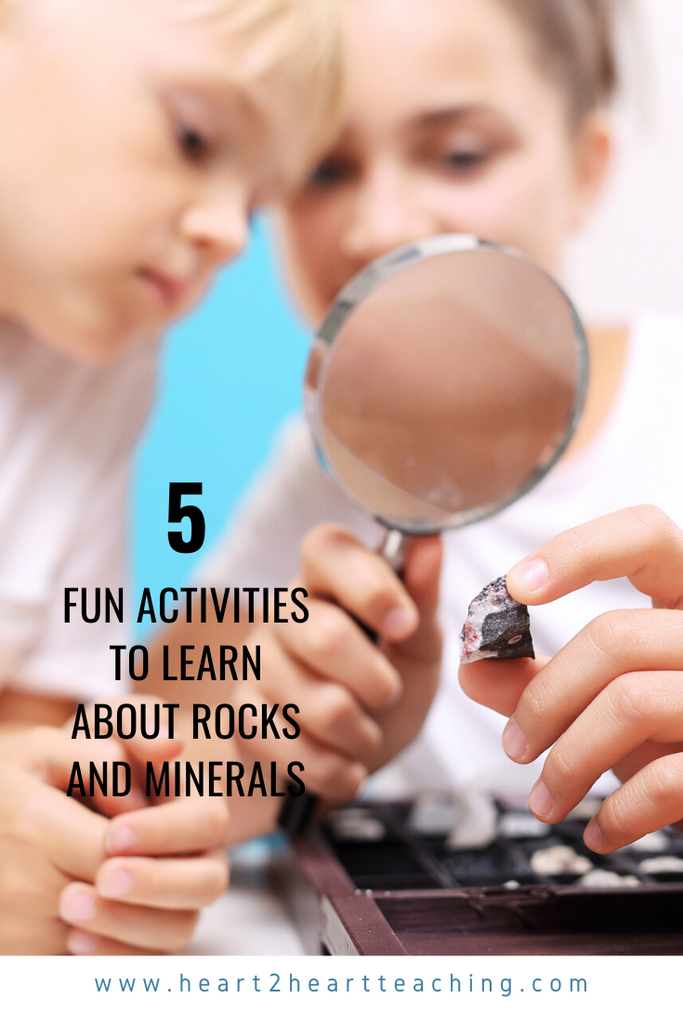Investigations in Science is such an important skill for upper elementary students. In this Rocks and Minerals Unit, students will learn and complete a variety of activities to help them fully understand and investigate rocks and minerals. Let's take a closer look at five activities included in this unit.
1. Leveled Passages About Three Types of Rocks
This unit is loaded with leveled reading passages to read about the different types of rocks and minerals. In this unit, you will find 10 leveled reading passages that look the same. The passages come in THREE levels of difficulty so that you can meet each student’s reading level with the same content information. Each passage has the same key ideas and essential information.
Read the leveled reading passages about rocks and minerals and complete the organizers. Each of the passages has comprehension questions to check for understanding. Watch the videos and complete the various hands-on activities in this pack to reinforce learning. These activities work well in small groups, partners, or stations.
This unit includes many interactive activities and learning opportunities for students with leveled reading passages that focus on:
- Rocks and minerals
- Igneous Rock
- Sedimentary Rock
- Metamorphic Rock
- Amazing Minerals
- Colorful Crystals
- Layers of the Earth
- Tectonic Plates
- Volcanoes
- The Rock Cycle





2. Be A Geologist!
This unit has 8 labs where students work as geologists to identify two mystery minerals. NOTE: Extra supplies are needed to complete the labs.
Rocks and minerals can be identified by their color, hardness, luster, magnetism, and streak test.
Divide the class into pairs. Give each pair of students TWO numbered rock samples to identify. Acting as geologists, students perform a series of tests at various stations around the room. Students record their descriptions, observations, and findings on their activity sheets. After completing the tests, students use the Mineral Identification Guide to try and identify their rocks. Ask students to identify their rocks and let them know if their identifications are correct.

Using this lab component and unit:
1. Students will explore the properties of some common minerals.
2. Write a description based on their observations of each rock sample.
3. Make educated guesses and try to identify two numbered rock samples.

3. Dive Deep With Vocabulary
Introduce the vocabulary words with the real-life photo posters included. You could post these posters around the classroom and have students travel around to match up and define the words in their flip flaps or spotlight on the vocabulary page. These inksaver posters make an excellent bulletin board display in a snap.


4. Lots of Hands-on Activities
Students can complete the following activities:
- Three Types of Rocks Pocket Sort
- Three short videos on safeshare.tv
- Facts About Rocks and Mineral Notebook Flaps
- Label The Rock Cycle
- Name That Rock or Mineral Activity
- Label and Color the Layers of the Earth
- Layers of the Earth Flip Flaps
- How are Mountains Formed (Tectonic Plates)




Flip Booklet (5 pages)Students flip for flipbooks! They can build the flipbook page by page. I usually have them do one page at each center or station. They can use the articles as a reference source to help them complete the pages of the flip-up. Lastly, they cut, color, and assemble the booklet. Flip-up books can be glued or stapled inside their interactive notebooks.
5. Rocks and Minerals Rock! Brochure Activity

Creating a brochure or tri-fold booklet is a fantastic way to wrap up the unit. Copy the two pages back to back. Have students answer the question on both sides of the tri-fold booklet. Next, they can color them. Then have the students cut along the outside rectangle border. Fold both of the flaps on the dotted lines so that it looks like a brochure.
Teacher Directions & Pacing Calendar Are Included

Plus the following teacher timesavers are included:
- Three Short Prescreened Videos
- Mineral Field Guide (4-pages)
- Unit Test (Editable)
- Answer Keys
The Unit's Essential Questions:
• How are rocks changed?
• Explain the difference between erosion and weathering.
• What are the three types of rocks?
• What is sediment?
• How are rocks and minerals related?
• How is an igneous rock formed?
• Name and describe three types of igneous rock.
• How is a sedimentary rock formed?
• Name and describe three types of sedimentary rock.
• How is a metamorphic rock formed?
• Name and describe three types of metamorphic rock.
• Explain the rock cycle.
• What is a mineral?
• How are minerals helpful?
• How are crystals formed?
• What are the layers of the Earth?
• How are mountains formed?
• Name and describe three types of mountains.
• What is a volcano?
• How can a volcano affect our environment?

Pin it to Save it for Later!




